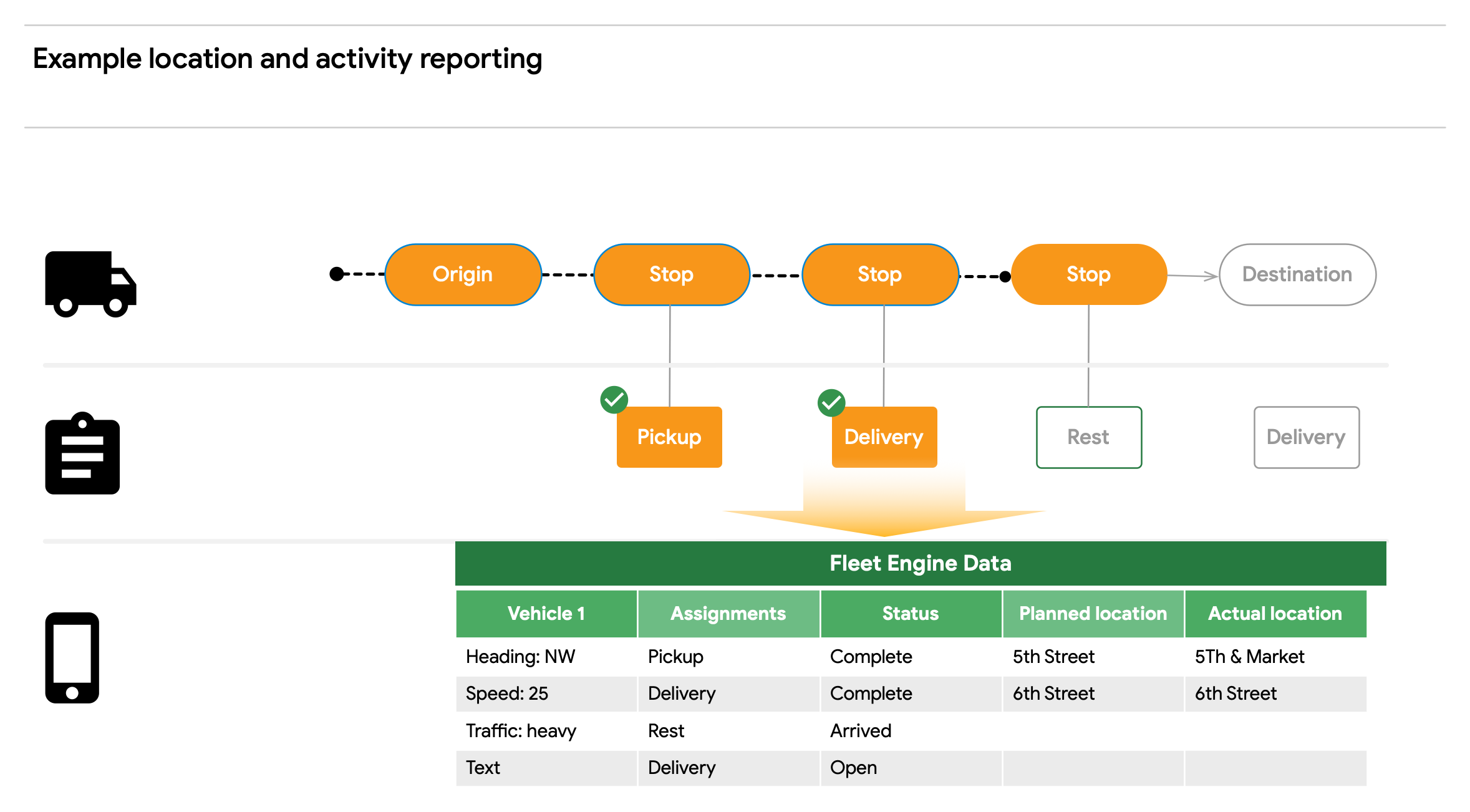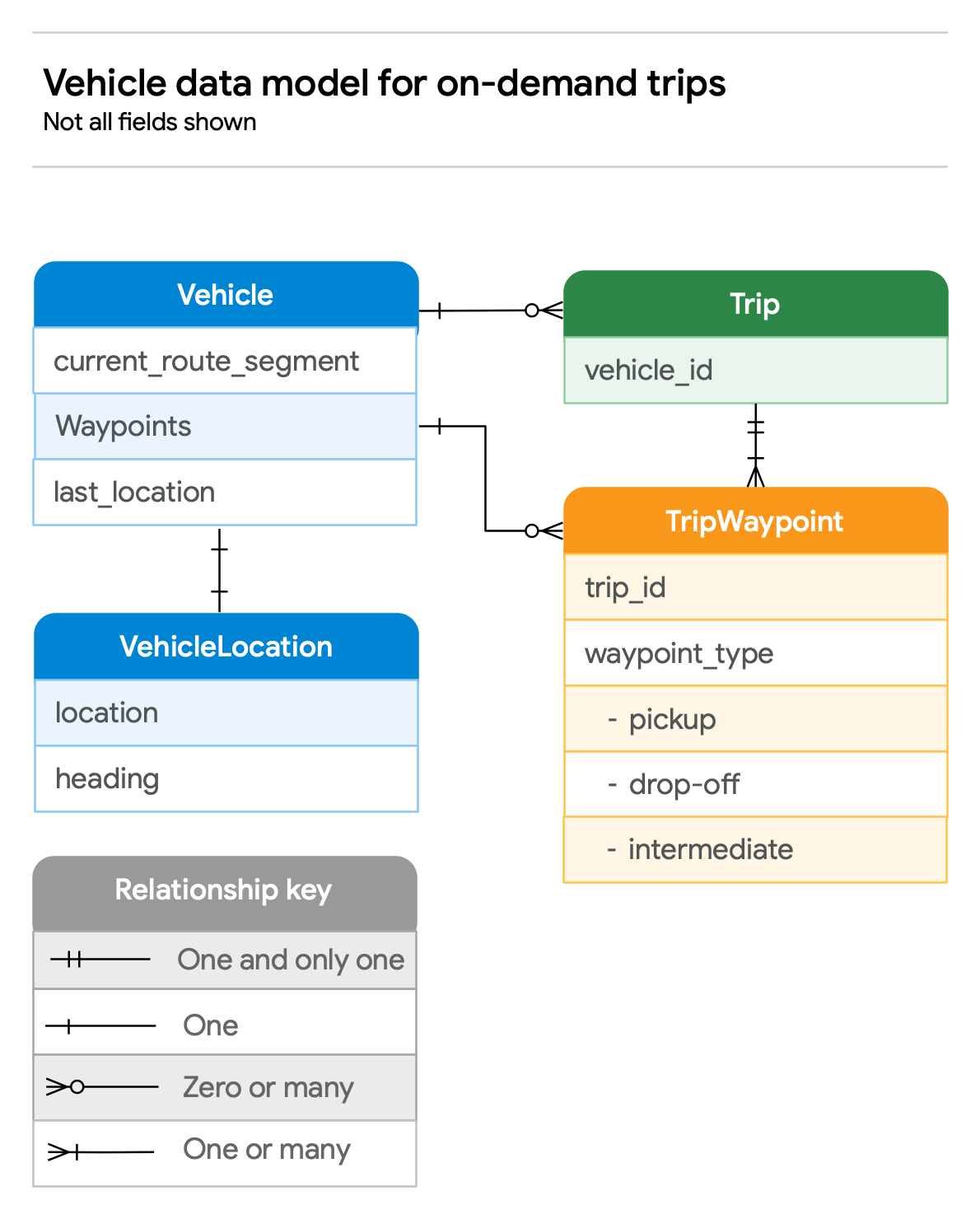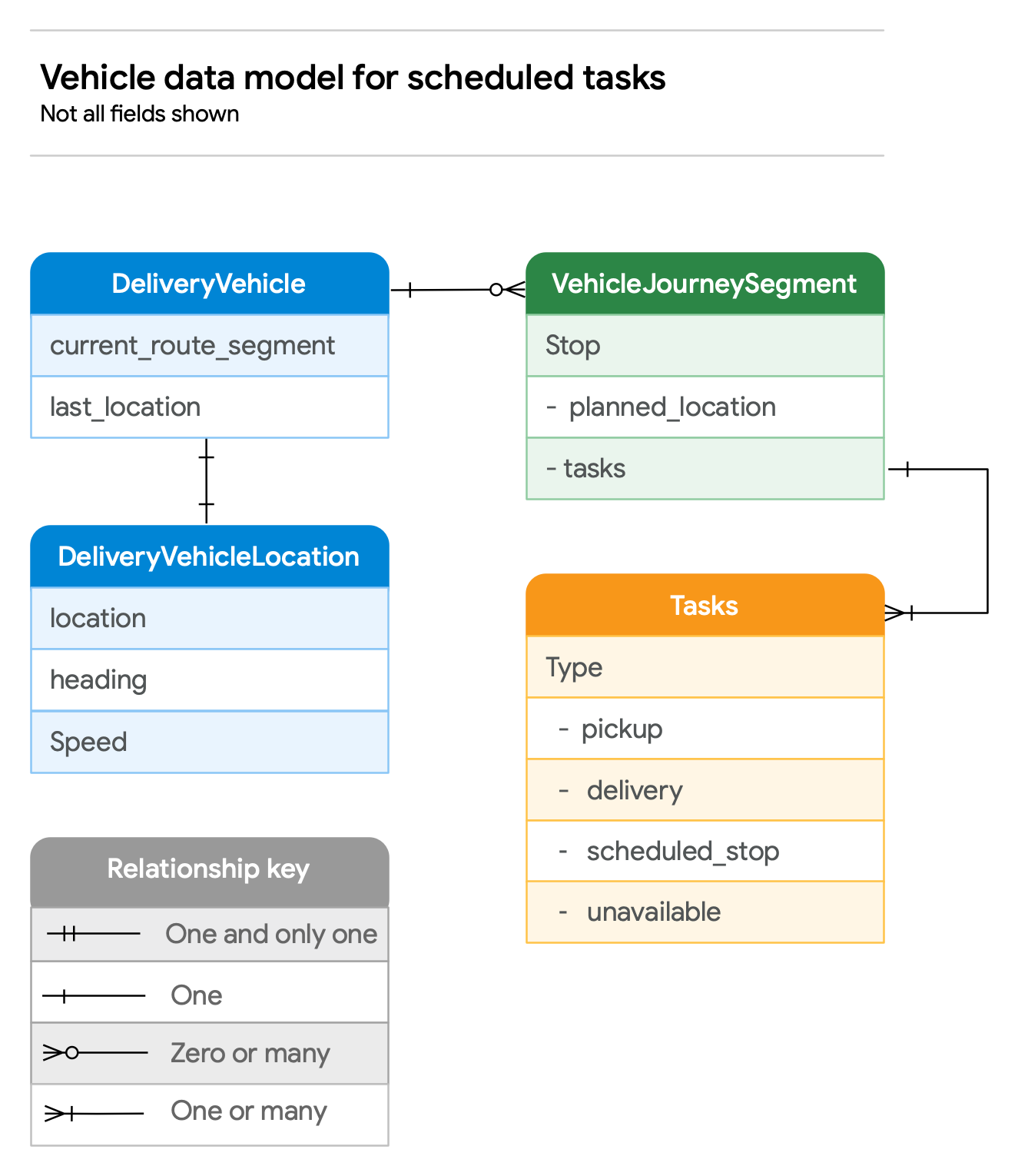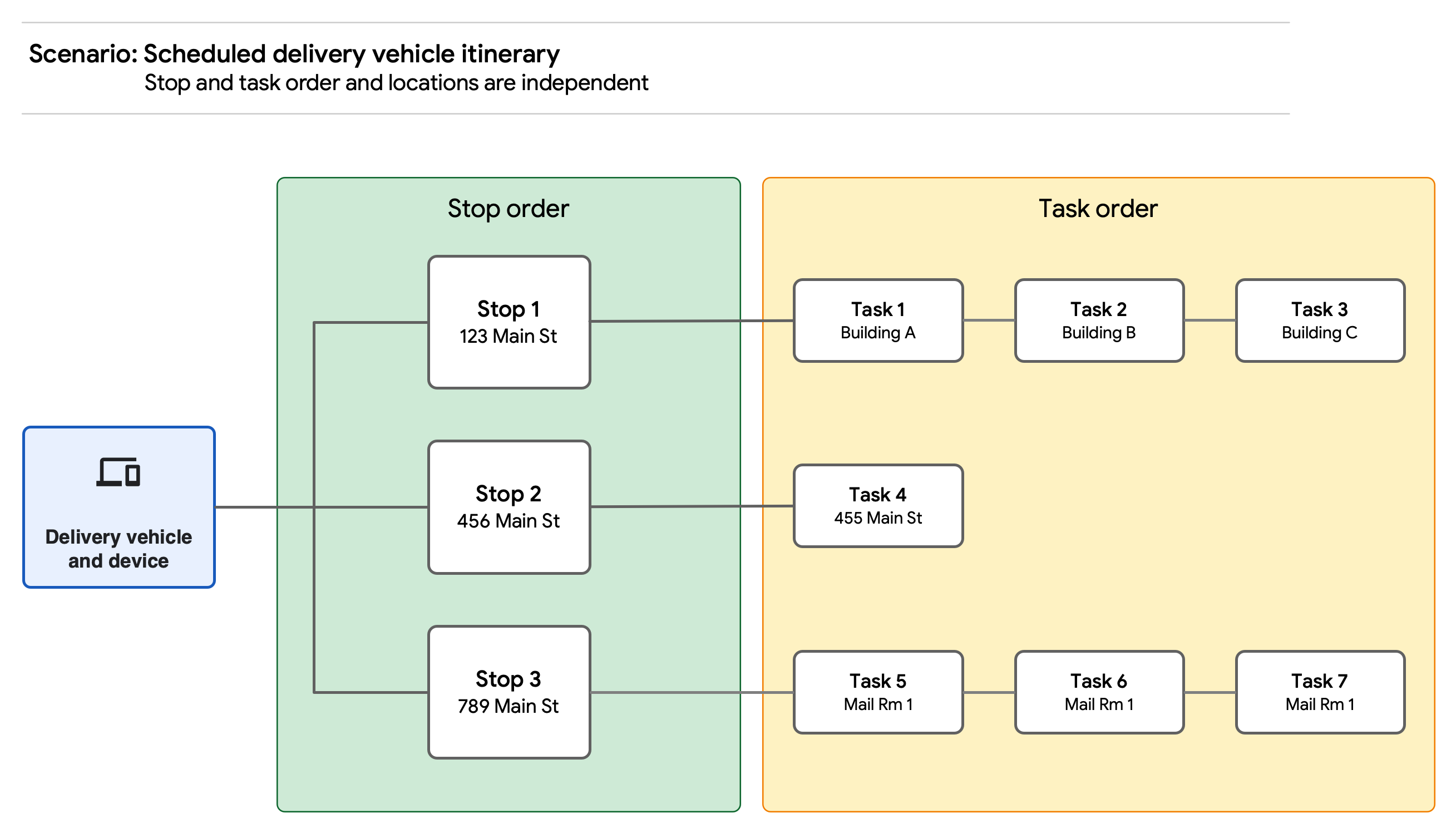이 가이드에서는 Fleet Engine 차량의 핵심 개념과 작동 방식을 설명합니다. Fleet Engine이란 무엇인가요?를 읽고 구체적인 귀하가 이용하는 모바일 서비스 제품:
차량이란 무엇인가요?
Fleet Engine에서 차량은 실제 차량을 나타내는 데이터 항목입니다. 출발지에서 집으로 상품이나 사람을 운송하기 위해 운전자가 사용하는 운송 수단 있습니다.
차량 항목은 다음 중 하나를 달성하는 메커니즘입니다.
- 한 시간 동안 할당된 승차 및 하차 위치에 대한 주문형 이동을 관리합니다. 드라이버의 날입니다.
- 운전자가 기다리는 동안 계획된 일련의 작업을 위해 예약된 정류장을 관리합니다. 있습니다.
이 그림은 차량-기기 쌍으로 차량을 나타냅니다. 이 드라이버가 드라이버 애플리케이션을 실행하는 장치를 사용한다고 가정합니다. 앱은 하루 종일 위치 업데이트 스트림을 Fleet Engine으로 전송합니다. 운전자는 또한 앱을 사용하여 다음 날짜 전에 과제를 수락하고 완료로 표시합니다. 정류장을 벗어납니다 Fleet Engine에서 이 데이터를 저장하며 사용자는 위치 정보와 비즈니스 활동 상태 통합 적합하다고 판단되는 차량 운영자를 위한 솔루션을 빌드할 수 있습니다.

차량 및 여정 요소의 데이터 모델
다음 다이어그램은 Google Cloud의
예정된 정류장의 경우 DeliveryVehicle, 주문형 경로의 경우 Vehicle입니다.
주문형 경로

예약된 작업

차량 운행 일정
이 섹션에서는 Fleet Engine의 여행 일정 개념을 소개합니다. 이 여행 일정은 차량을 위한 배정 모음입니다. 특정 작업 기간(예: 하루)입니다. 예약된 서비스의 경우 여기에는 매니페스트 및 전송 순서를 지정합니다 주문형의 경우 여기에는 지정된 기간에 할당된 이동의 수입니다. 차량은 다음 시점에 여정을 완료합니다. 관련된 모든 정류장이 삭제되었습니다.
이 다이어그램은 차량 여정의 샘플 작업을 보여줍니다.
주문형 경로

이 시나리오는 연달아 두 번 운행하는 운항 일정을 나타냅니다.
위치를 탭합니다. 여기서 경로 1의 하차 위치는 승차 위치와 동일합니다.
이동 2의 위치입니다.
예약된 작업

이 시나리오는 다양한 경유지와 작업이 있는 일정을 나타냅니다.
위치 참고: Fleet Engine은 주소 정보를 저장하지 않습니다.
이 다이어그램에서 차량이 한 지점에서 정차하는 방식을
서로 다른 위치를 가진 할 일과 관련된 위치
차량 위치
Fleet Engine에서 차량 위치는 특정 차량의 구체적인 지리적 위치입니다.
운송 수단에 연결된다는 점과 관계없이
정류장에 도착하거나 정류장에서 출발했습니다. Fleet Engine은 last_location 필드를 사용합니다.
차량 객체에서 실시간에 가까운 위치 데이터를 수집하고
기타 이동 데이터가 있을 수 있습니다.
다음 표에는 위치 업데이트 전송에 관한 가이드라인이 나와 있습니다. Fleet Engine으로 전송:
| 차량 위치 | |||||
|---|---|---|---|---|---|
| 빈도 |
권장: 기본값(1회)을 사용합니다.
10초마다
위치 빈도 업데이트를 변경하는 경우 (권장하지 않음)
1분마다 최소 한 번, 1분마다 최대 한 번만 전송해야 합니다.
5초
|
||||
| 위치 업데이트 방법 |
|
||||
| 안내 |
관련 안내:
작업 할당 및 순서 지정 가이드에서 __작업 업데이트__를 참조하세요.
여행 관리 가이드에서 __이동 상태를 업데이트__합니다.
|
||||
차량 정류장
차량 정류장은 차량 여정의 핵심 요소이며, 차량의 출발지에서 특정 할당이 종료되는 시점까지의 차량 경로입니다.
차량에 대한 작업 또는 이동 할당을 만들고 관리할 때 해당 할당이 수행되고 해당 위치는 작업 또는 이동 활동으로 차량 이동을 위해 지정된 정류장입니다.
- 주문형 이동의 경우 지정된 정류장에서 승차 또는 하차 활동이 발생합니다. 위치(온디맨드 데이터 모델에서는 이동 경유지라고 함)
- 예약된 정류장의 경우 정류장에는 완료할 작업 목록이 포함됩니다. 여러 차량을 배달하고 픽업하는 등 패키지입니다 특정 정류장에 예정된 휴식 시간을 지정할 수도 있습니다.
일반적으로 운전자가 할당된 작업을 지우면 여정이 완료됩니다. 확인할 수 있습니다 이 시점에서 거래 상태를 Fleet Engine으로 전송합니다. 나중에 분석 및 결제에 사용할 수 있습니다

